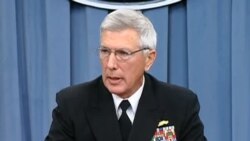PENTAGON —
One of the main features of the global defense strategy laid out by President Barack Obama two years ago, shifting the U.S. military's focus from the Middle East to the Asia Pacific region, is meeting significant challenges from China and its rapidly developing military power.
But U.S. military officials say American dominance of the Asia Pacific is not diminishing.
Recent actions by China, including its imposition of an aircraft identification zone over the East China Sea and a near collision between Chinese and U.S. warships, show that dominance is being challenged.
The Obama administration, in its efforts to shift focus from wars in Iraq and Afghanistan to the Pacific, where China has been building up its forces, includes strategic placement of a new aircraft carrier and the development of hypersonic missile technology.
According to Admiral Samuel Locklear, commander of U.S. forces in the Pacific, interactions with Chinese forces in the region will only increase, and he is calling for a pragmatic approach that includes boosting military-to-military relations with China.
"We have to do better at being able to communicate with each other in a way that allows us to not lead to miscalculation that won't be productive in the security environment,” he said.
Defense analysts such Barry Pavel of the Washington-based Atlantic Council, a nonpartisan think tank that promotes constructive leadership and engagement in international affairs based on the central role of the Atlantic Community, question whether the shift in focus has actually meant a strengthening of forces in the Pacific.
“We have the deployment of 2,500 or so Marines to northern Australia that'll be there on a routine basis, not a very big nor significant deployment in my estimation," he said. "There's a couple of ships. I think they were littoral combat ships that were discussed as being home ported in Singapore, and then there really hasn't been anything else.”
The placing of a combat ship in Singapore is one of the visible signs of that refocus. The United States has announced the aircraft carrier USS Ronald Reagan is replacing the George Washington at Yokosuka in Japan - a one-for-one swap, but one the Navy says is an element of the rebalance.
U.S. officials are reviewing their military commitments to allies in the region and say they could add more ships, equipment and troops in the future.
With the U.S. military facing its biggest downsizing since the end of World War II, analysts say it remains to be seen how large any future military investment in the Pacific will be.
But U.S. military officials say American dominance of the Asia Pacific is not diminishing.
Recent actions by China, including its imposition of an aircraft identification zone over the East China Sea and a near collision between Chinese and U.S. warships, show that dominance is being challenged.
The Obama administration, in its efforts to shift focus from wars in Iraq and Afghanistan to the Pacific, where China has been building up its forces, includes strategic placement of a new aircraft carrier and the development of hypersonic missile technology.
According to Admiral Samuel Locklear, commander of U.S. forces in the Pacific, interactions with Chinese forces in the region will only increase, and he is calling for a pragmatic approach that includes boosting military-to-military relations with China.
"We have to do better at being able to communicate with each other in a way that allows us to not lead to miscalculation that won't be productive in the security environment,” he said.
Defense analysts such Barry Pavel of the Washington-based Atlantic Council, a nonpartisan think tank that promotes constructive leadership and engagement in international affairs based on the central role of the Atlantic Community, question whether the shift in focus has actually meant a strengthening of forces in the Pacific.
“We have the deployment of 2,500 or so Marines to northern Australia that'll be there on a routine basis, not a very big nor significant deployment in my estimation," he said. "There's a couple of ships. I think they were littoral combat ships that were discussed as being home ported in Singapore, and then there really hasn't been anything else.”
The placing of a combat ship in Singapore is one of the visible signs of that refocus. The United States has announced the aircraft carrier USS Ronald Reagan is replacing the George Washington at Yokosuka in Japan - a one-for-one swap, but one the Navy says is an element of the rebalance.
U.S. officials are reviewing their military commitments to allies in the region and say they could add more ships, equipment and troops in the future.
With the U.S. military facing its biggest downsizing since the end of World War II, analysts say it remains to be seen how large any future military investment in the Pacific will be.









